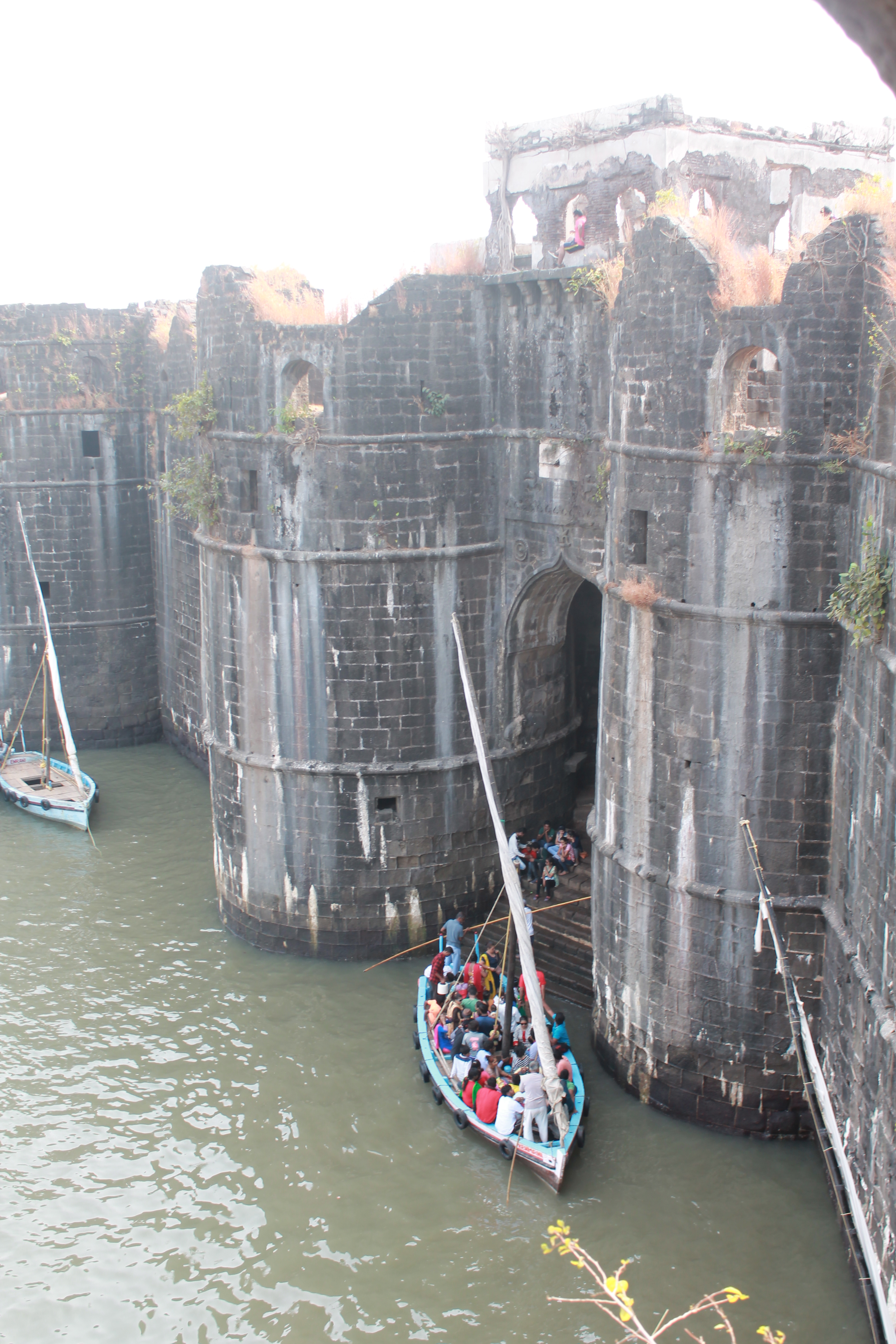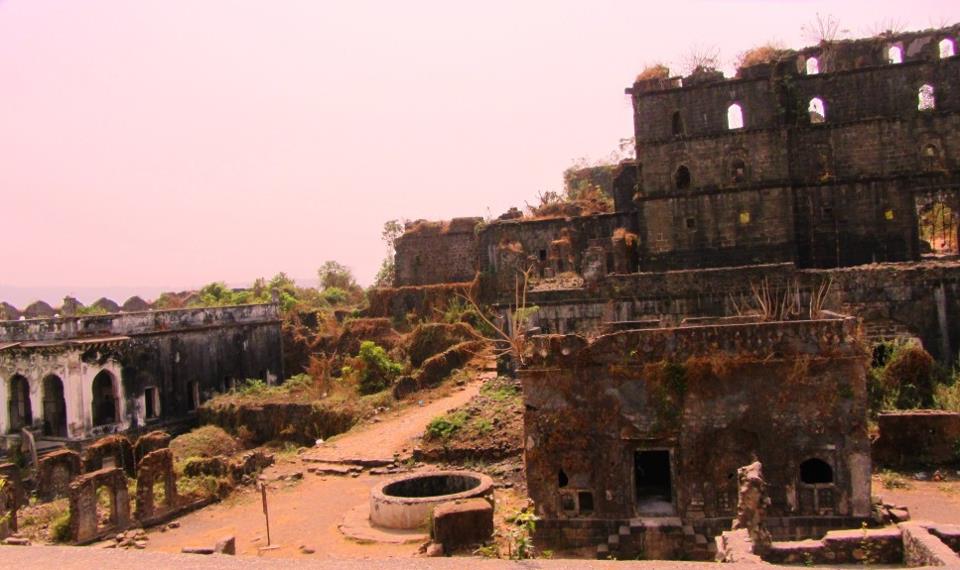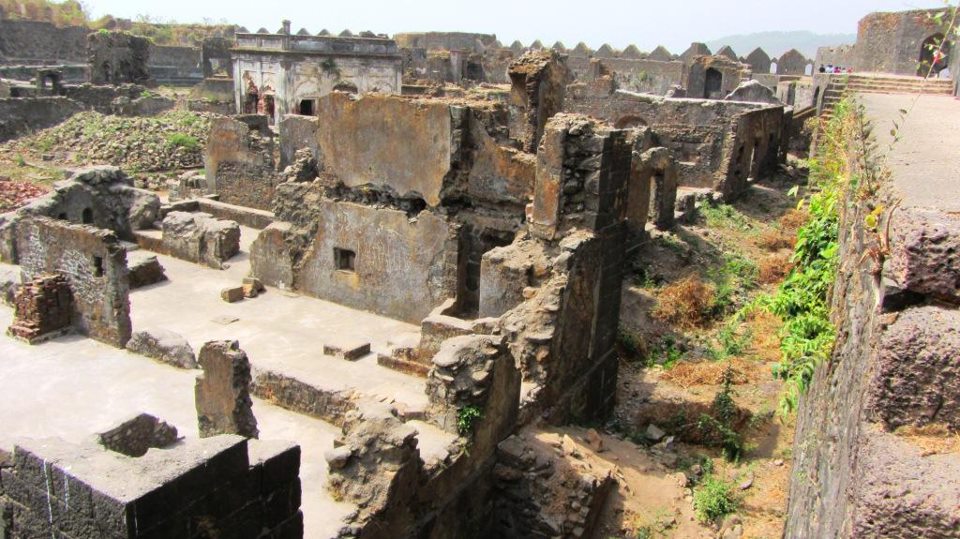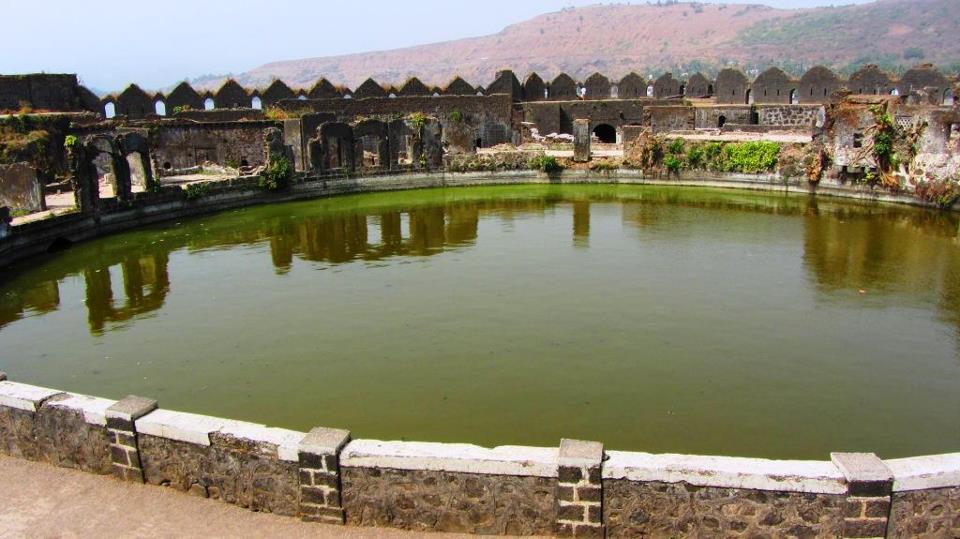Murud-Janjira on:
[Wikipedia]
[Google]
[Amazon]
Murud-Janjira () is the local name of a famous fort and tourist spot situated on an island just off the coastal town/city of Murud, in the

 Murud-Janjira Fort is situated on an oval-shaped rock off the Arabian Sea coast near the port city of Murud, south of
Murud-Janjira Fort is situated on an oval-shaped rock off the Arabian Sea coast near the port city of Murud, south of  The main gate of the fort faces Rajapuri on the shore and can be seen only when one is about away from it. It has a small postern gate towards the open sea for escape.
The main gate of the fort faces Rajapuri on the shore and can be seen only when one is about away from it. It has a small postern gate towards the open sea for escape.
 The fort has 26 artillery towers still intact. There are many cannons of native and European make rusting on the towers. Now in ruins, the fort in its heyday was a full-fledged living fort with all the necessary facilities, e.g.,Barracks, quarters for officers, mosque, two small fresh water ponds etc. On the outer wall flanking the main gate, there is a sculpture depicting a tiger-like beast clasping elephants in its claws.
The fort has 26 artillery towers still intact. There are many cannons of native and European make rusting on the towers. Now in ruins, the fort in its heyday was a full-fledged living fort with all the necessary facilities, e.g.,Barracks, quarters for officers, mosque, two small fresh water ponds etc. On the outer wall flanking the main gate, there is a sculpture depicting a tiger-like beast clasping elephants in its claws.
 The palace of the Nawabs of Janjira at Murud is still in good shape.
A special attraction of this fort are 3 gigantic
The palace of the Nawabs of Janjira at Murud is still in good shape.
A special attraction of this fort are 3 gigantic
 During its heyday, the island fort boasted 572 cannons.
Visitors can gain access to the Janjira fort from Rajapuri, a small village on the coast. After a short ride in a small boat, one can enter the fort through the main entrance. The fort is oval shaped instead of the usual oblong or square shape. The fort wall is about 40 feet high and has 19 rounded porches or arches, some of which still have cannons mounted on them, including the famous cannon Kalaal Baangadi. These cannons were largely responsible for repelling oncoming enemies from the sea. Inside the fort walls are the ruins of a mosque, a palace and bath with water channeled from streams. There is evidence that royal ladies occupied quarters here. A deep well, still functional, provides fresh water despite the fort being surrounded by salt water.
On shore is a luxurious cliff-top mansion, the Palace of the Nawab. Built by the former Nawab of Janjira, it commands a panoramic view of the Arabian sea and the Janjira sea fort.
According to another record, the Abyssinian Sidis established the Janjira and Jafarabad state in early 1100.
During its heyday, the island fort boasted 572 cannons.
Visitors can gain access to the Janjira fort from Rajapuri, a small village on the coast. After a short ride in a small boat, one can enter the fort through the main entrance. The fort is oval shaped instead of the usual oblong or square shape. The fort wall is about 40 feet high and has 19 rounded porches or arches, some of which still have cannons mounted on them, including the famous cannon Kalaal Baangadi. These cannons were largely responsible for repelling oncoming enemies from the sea. Inside the fort walls are the ruins of a mosque, a palace and bath with water channeled from streams. There is evidence that royal ladies occupied quarters here. A deep well, still functional, provides fresh water despite the fort being surrounded by salt water.
On shore is a luxurious cliff-top mansion, the Palace of the Nawab. Built by the former Nawab of Janjira, it commands a panoramic view of the Arabian sea and the Janjira sea fort.
According to another record, the Abyssinian Sidis established the Janjira and Jafarabad state in early 1100.
 According to accounts written by the Portuguese Admiral
According to accounts written by the Portuguese Admiral 
 In the year 1736, Siddis of Murud-Janjira set out in a battle with the forces of Maratha Peshwa Baji Rao. On 19 April 1736, Maratha warrior Nanaji Surve and
In the year 1736, Siddis of Murud-Janjira set out in a battle with the forces of Maratha Peshwa Baji Rao. On 19 April 1736, Maratha warrior Nanaji Surve and
Raigad district
Raigad district (Marathi pronunciation: �aːjɡəɖ, previously Colaba district, is a district in the Konkan division of Maharashtra, India.
The district was renamed to Raigad after the fort that was the first capital of the former Marath ...
of Maharashtra, India
India, officially the Republic of India (Hindi: ), is a country in South Asia. It is the seventh-largest country by area, the second-most populous country, and the most populous democracy in the world. Bounded by the Indian Ocean on the so ...
.
Origins of the name
The word Janjira is a corruption of the arabic word "Jazira", which means island in the Arabic language. Murud was once known in Marathi as ''Habsan'' ("ofHabshi
The Siddi (), also known as the Sheedi, Sidi, or Siddhi, or Habshi are an ethnic group inhabiting India and Pakistan. They are primarily descended from the Bantu peoples of the Zanj coast in Southeast Africa and Ethiopia, most whom arrived to ...
" or Abyssinian). The name of the fort is a concatenation of the Konkani and Marathi words, "murud" and "Janjiri". The word "morod" is peculiar to Konkani and is absent in Marathi.
Ramrao Patil of Janjira
Raja Ram Rao Patil was Patil of Janjira Island and a chief ofKolis
The Koli is an Indian caste found in Rajasthan, Himachal Pradesh, Gujarat, Maharashtra, Uttar Pradesh, Haryana, Karnataka, Odisha and Jammu and Kashmir states in India. Koli is an agriculturist caste of Gujarat but in coastal areas the ...
who established and/or built this island in the 15th century for Kolis to live peacefully away from pirates. After gaining permission from the Sultan of the Ahmadnagar Sultanate, he built the island but later refused to obey the orders of the Sultan. So the Sultan sent his Admiral Piram Khan in 1489 to capture the janjira. Due to the castle's fortifications, Piram Khan was unable to attack the island conventionally, so he disguised himself as a merchant and requested to stay a night at janjira and permission was granted. Piram Khan hosted a party under the guise of thanking the Patil. When the Patil and kolis were intoxicated, Piram Khan attacked them with his men who had been hidden in barrels and captured the island.
Major features

 Murud-Janjira Fort is situated on an oval-shaped rock off the Arabian Sea coast near the port city of Murud, south of
Murud-Janjira Fort is situated on an oval-shaped rock off the Arabian Sea coast near the port city of Murud, south of Mumbai
Mumbai (, ; also known as Bombay — List of renamed Indian cities and states#Maharashtra, the official name until 1995) is the capital city of the Indian States and union territories of India, state of Maharashtra and the ''de facto'' fin ...
. Janjira is considered one of the strongest coastal forts in India. The fort is approached by sailboats from Rajapuri jetty.  The main gate of the fort faces Rajapuri on the shore and can be seen only when one is about away from it. It has a small postern gate towards the open sea for escape.
The main gate of the fort faces Rajapuri on the shore and can be seen only when one is about away from it. It has a small postern gate towards the open sea for escape.
 The fort has 26 artillery towers still intact. There are many cannons of native and European make rusting on the towers. Now in ruins, the fort in its heyday was a full-fledged living fort with all the necessary facilities, e.g.,Barracks, quarters for officers, mosque, two small fresh water ponds etc. On the outer wall flanking the main gate, there is a sculpture depicting a tiger-like beast clasping elephants in its claws.
The fort has 26 artillery towers still intact. There are many cannons of native and European make rusting on the towers. Now in ruins, the fort in its heyday was a full-fledged living fort with all the necessary facilities, e.g.,Barracks, quarters for officers, mosque, two small fresh water ponds etc. On the outer wall flanking the main gate, there is a sculpture depicting a tiger-like beast clasping elephants in its claws.
 The palace of the Nawabs of Janjira at Murud is still in good shape.
A special attraction of this fort are 3 gigantic
The palace of the Nawabs of Janjira at Murud is still in good shape.
A special attraction of this fort are 3 gigantic cannons
A cannon is a large- caliber gun classified as a type of artillery, which usually launches a projectile using explosive chemical propellant. Gunpowder ("black powder") was the primary propellant before the invention of smokeless powder dur ...
named Kalalbangdi, Chavri and Landa Kasam. These cannons were said to be feared for their shooting range. Another gate to the west is sea-facing, called 'Darya Darwaza'.
There is also another fortress, named Ghosalgad, which is located on top of the hill around east of Murud-Janjira, that was used as outpost for the rulers of Janjira.
History
 During its heyday, the island fort boasted 572 cannons.
Visitors can gain access to the Janjira fort from Rajapuri, a small village on the coast. After a short ride in a small boat, one can enter the fort through the main entrance. The fort is oval shaped instead of the usual oblong or square shape. The fort wall is about 40 feet high and has 19 rounded porches or arches, some of which still have cannons mounted on them, including the famous cannon Kalaal Baangadi. These cannons were largely responsible for repelling oncoming enemies from the sea. Inside the fort walls are the ruins of a mosque, a palace and bath with water channeled from streams. There is evidence that royal ladies occupied quarters here. A deep well, still functional, provides fresh water despite the fort being surrounded by salt water.
On shore is a luxurious cliff-top mansion, the Palace of the Nawab. Built by the former Nawab of Janjira, it commands a panoramic view of the Arabian sea and the Janjira sea fort.
According to another record, the Abyssinian Sidis established the Janjira and Jafarabad state in early 1100.
During its heyday, the island fort boasted 572 cannons.
Visitors can gain access to the Janjira fort from Rajapuri, a small village on the coast. After a short ride in a small boat, one can enter the fort through the main entrance. The fort is oval shaped instead of the usual oblong or square shape. The fort wall is about 40 feet high and has 19 rounded porches or arches, some of which still have cannons mounted on them, including the famous cannon Kalaal Baangadi. These cannons were largely responsible for repelling oncoming enemies from the sea. Inside the fort walls are the ruins of a mosque, a palace and bath with water channeled from streams. There is evidence that royal ladies occupied quarters here. A deep well, still functional, provides fresh water despite the fort being surrounded by salt water.
On shore is a luxurious cliff-top mansion, the Palace of the Nawab. Built by the former Nawab of Janjira, it commands a panoramic view of the Arabian sea and the Janjira sea fort.
According to another record, the Abyssinian Sidis established the Janjira and Jafarabad state in early 1100.
 According to accounts written by the Portuguese Admiral
According to accounts written by the Portuguese Admiral Fernão Mendes Pinto
Fernão Mendes Pinto (; c.1509 – 8 July 1583) was a Portuguese explorer and writer. His voyages are recorded in ''Pilgrimage'' ( pt, Peregrinação) (1614), his autobiographical memoir. The historical accuracy of the work is debatable due t ...
, the Ottoman fleet that first arrived in Aceh prior to the Ottoman expedition to Aceh
The Ottoman expedition to Aceh started from around 1565 when the Ottoman Empire endeavoured to support the Aceh Sultanate in its fight against the Portuguese Empire in Malacca. The expedition followed an envoy sent by the Acehnese Sultan Alauddin ...
led by Kurtoğlu Hızır Reis
Kurtoğlu Hızır Reis was an Ottoman admiral who is best known for commanding the Ottoman naval expedition to Sumatra in Indonesia (1568–1569).
Background and family origins
Kurtoğlu Hızır Reis was the son of the famous Turkish private ...
included 200 Malabar sailors from Janjira to aid the region of Batak and Maritime Southeast Asia
Maritime Southeast Asia comprises the countries of Brunei, Indonesia, Malaysia, the Philippines, Singapore, and East Timor. Maritime Southeast Asia is sometimes also referred to as Island Southeast Asia, Insular Southeast Asia or Oceanic Sout ...
in 1539. Later, in 1621, the Siddis of Janjira became exceptionally powerful as autonomous state to the point that the commander of Janjira, Siddi Ambar the Little, successfully defied his overlord Malik Ambar
Malik Ambar (1548 – 13 May 1626) was a Siddi military leader and prime minister who became a kingmaker and de facto ruler of the Ahmadnagar Sultanate in the Deccan region of India.
Born in the Adal Sultunate, in present-day Ethiopia, Mali ...
's attempt to replace him. Siddi Ambar the Little is accordingly considered the first Nawab of Janjira state.
The island fortress was under control of Adil Shahi dynasty until the reign of Ibrahim II where Janjira fort was lost to the Siddis.
Major historical figures from Murud-Janjira include men such as Sidi Hilal, Yahya Saleh and Sidi Yaqub. During the rule of Sultan Aurangzeb, Sidi Yaqut received a subsidy of 400,000 rupees. He also owned large ships which weighed 300–400 tons. According to the record these ships were unsuitable for fighting on the open sea against European warships, but their size allowed for transporting soldiers for amphibious operations.
Despite their repeated attempts, the Portuguese
Portuguese may refer to:
* anything of, from, or related to the country and nation of Portugal
** Portuguese cuisine, traditional foods
** Portuguese language, a Romance language
*** Portuguese dialects, variants of the Portuguese language
** Portu ...
, the British
British may refer to:
Peoples, culture, and language
* British people, nationals or natives of the United Kingdom, British Overseas Territories, and Crown Dependencies.
** Britishness, the British identity and common culture
* British English, ...
and the Marathas
The Marathi people ( Marathi: मराठी लोक) or Marathis are an Indo-Aryan ethnolinguistic group who are indigenous to Maharashtra in western India. They natively speak Marathi, an Indo-Aryan language. Maharashtra was formed as a ...
failed to subdue the power of the Siddis, who were themselves allied with the Mughal Empire
The Mughal Empire was an early-modern empire that controlled much of South Asia between the 16th and 19th centuries. Quote: "Although the first two Timurid emperors and many of their noblemen were recent migrants to the subcontinent, the d ...
. For example, 10,000 soldiers from Moro Pandit were repulsed by Janjira's army in 1676. The Maratha
The Marathi people ( Marathi: मराठी लोक) or Marathis are an Indo-Aryan ethnolinguistic group who are indigenous to Maharashtra in western India. They natively speak Marathi, an Indo-Aryan language. Maharashtra was formed as ...
s led by Chhatrapati Shivaji Maharaj attempted to scale the granite
Granite () is a coarse-grained ( phaneritic) intrusive igneous rock composed mostly of quartz, alkali feldspar, and plagioclase. It forms from magma with a high content of silica and alkali metal oxides that slowly cools and solidifies under ...
walls; he failed in all his attempts. His son Chhatrapati Sambhaji maharaj even attempted to tunnel his way into the fort and was very close to capture the fort, but at the same time a Mughal army attacked Maratha capital, so Sambhaji had to withdraw his forces from the siege and go to save Maratha capital. He built another sea fort in 1676, known as Padmadurg or Kasa fort, to challenge Janjira. It is located northeast of Janjira. Padmadurg took 22 years to build and is constructed on 22 acres of land.

 In the year 1736, Siddis of Murud-Janjira set out in a battle with the forces of Maratha Peshwa Baji Rao. On 19 April 1736, Maratha warrior Nanaji Surve and
In the year 1736, Siddis of Murud-Janjira set out in a battle with the forces of Maratha Peshwa Baji Rao. On 19 April 1736, Maratha warrior Nanaji Surve and Chimaji Appa
Chimaji Balaji Bhat was born in a Chitpavan caste family in 1707 and died in 1740, commonly referred to as Appa or Bhau, was the son of Balaji Vishwanath Bhat and the younger brother of Bajirao Peshwa of Maratha Empire. He was an able military ...
attacked the gathering forces in the encampments of the Siddis near Rewas.Advance Study in the History of Modern India (Volume-1: 1707-1803) By G.S.Chhabra When the confrontation ended, 1,500 Siddis, including their leader Siddi Sat, were killed. Peace was brokered in September 1736, but the Siddis were confined to only Janjira, Gowalkot, and Anjanwel, with their power greatly reduced. However, Janjira remained unconquered until it became part of Indian territory after independence from the British in 1947.
See also
* Murud *List of Indian Princely States
Before the Partition of India in 1947, about 584 princely states, also called "native states", existed in India, which were not fully and formally part of British India, the parts of the Indian subcontinent which had not been conquered or an ...
* List of forts in Maharashtra
This is list of forts in Maharashtra a state of India
# Achala Fort (Nashik)
# Agashi Fort
# Ahmednagar Fort
# Ahivant Fort
# Ajinkyatara
# Akola Fort
# Akluj Fort
# Alang Fort
# Ambolgad
# Anjaneri
# Anjanvel Fort
# Ankai Fort
# Antur Fo ...
* Khokri Tombs
The Khokari (or Khokri) tombs are three 500-year-old massive stone tombs of the early rulers of the erstwhile Janjira State in western India, near Murud in Maharashtra state.
History
The largest is the tomb of Sidi Surul Khan, who was chief of ...
* Janjira State
Janjira State was a princely state in India during the British Raj. Its rulers were a Siddi dynasty of Habesha descent and the state was under the suzerainty of the Bombay Presidency.
Janjira State was located on the Konkan coast in the p ...
* Jafarabad State
* Maratha Navy
The Maratha Navy was the naval wing of the armed forces of the Maratha Empire, which existed from around mid-17th century to mid-18th century in India.
Formative years
Historian Sir Jadunath Sarkar noted:
In medieval India, the Muslim rul ...
* Siege of Janjira(1682)
Sources
* Imperial Gazetteer of India, 2. A., 26 Bde., Oxford 1908–1931 * Malleson, G. B.: ''An historical sketch of the native states of India'', London 1875, Reprint Delhi 1984 * Schwartzberg, Joseph E., Hrsg.: ''A historical atlas of South Asia'', 2. A., New York/Oxford 1992, * http://www.maharashtratourism.gov.in/MTDC/HTML/MaharashtraTourism/TouristDelight/Forts/Forts.aspx?strpage=Murud_JanjiraForts.html Maharashtra - Murud Janjira Forts Official Govt. PageReferences
{{Authority control Konkan Princely states of India Muslim princely states of India Islands of Maharashtra 1490 establishments in Asia 15th-century establishments in India Sea forts Forts in Raigad district